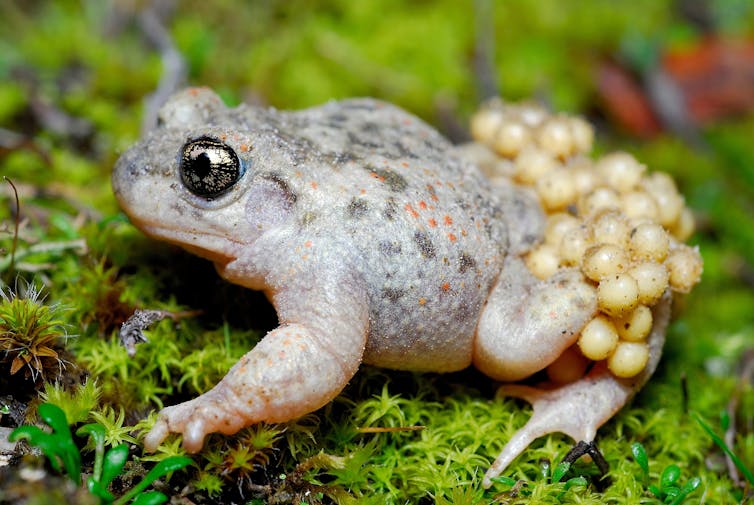
Animals in children’s stories are often depicted as living in neat mum, dad and children family units. Examples include Fantastic Mr Fox, 101 Dalmatians and, more recently, Peppa Pig and Bluey. But, this might leave people feeling like outsiders if they don’t come from a traditional nuclear family set-up.
In reality, there is a huge diversity in what family looks like within the animal kingdom.
In biparental care, a male and female animal raise their offspring together. This type of parental behaviour is predominantly seen in birds and is rare in invertebrates, fish and mammals.
Mute swans are a good example, where mum and dad can share the responsibilities of incubating eggs, feeding the cygnets and teaching them to be independent.
Single-parenting represents the most common form of family in the animal kingdom. Usually, males compete for access to females. This is because the female invests more in reproduction than the male. For example, in a typical mammal, the female is pregnant, suckles the young and raises it.
In some cases, such as leopards, the female raises the offspring completely on her own. In fact, single mothers are found in around 90% of mammals.
Such single-parenting is seen in children’s books like The Tale of Peter Rabbit by Beatrix Potter. Although, there are few stories where the mother chooses to single-parent, unlike in the animal kingdom where females of some species benefit from raising offspring alone.
For example, animals who are left in a nest while their parent or parents look for food may be safer from predators if only one parent is leaving scent trails as they come and go.
Sometimes the male raises the young on his own. This is more frequent in fish and amphibians, where the offspring hatch from eggs. The male midwife toad wraps his fertilised eggs around his back legs and carries them with him until they are ready to hatch.
Darwin’s frog has an alternative parenting tactic where the male carries his tadpoles in his vocal sac for six to eight weeks, until they are developed enough to face the world.
These types of behaviour allow the females to focus on feeding, which means she can produce more eggs for the next batch of young. Male parenting is also much less common in children’s books, but a popular exception is The Gruffalo’s Child by Julia Donaldson.

Homosexuality
Scientists have observed same sex couplings in over 500 species, including vultures, dolphins, giraffe, bonobos, geckos and dragonflies. Although life-long homosexuality in the wild is rare, in which animals forego heterosexual relationships, permanent male-male couplings have been seen in sheep.
Also, female albatrosses are known to sometimes reject males once their eggs have been fertilised, choosing to raise offspring in female-female relationships.
One of the most famous cases of homosexuality in captivity is that of Roy and Silo, a pair of chinstrap penguins from Central Park Zoo in New York, who formed such a strong bond in the early 2000s that the keeper gave them an egg to hatch and raise.
This story was turned into a popular children’s book And Tango Makes Three by Justin Richardson. Unfortunately, Silo’s head was turned by a female named Scrappy, ending his six-year relationship with Roy.
Same-sex parenting can be extended to species where large family units develop, such as elephants. Generally, elephant family units consist of several related females and their calves, led by an older matriarch. Sisters and grandmothers undertake allomothering, babysitting the youngsters, teaching them foraging, vigilance and defence, and sometimes even take on communal suckling of infants.
The story of one of the most famous communal parent species, the honey bee, has been turned into a novel for adults. The Bees by Laline Paull is the story of worker bee Flora 717, who helps feed her newborn sisters, and her life in the hive.
Communal parenting doesn’t have to be restricted to one sex, though. Many animals, including meerkats, are cooperative breeders. The young stay at home to help their parents to raise their baby siblings rather than go off and breed on their own. Most cooperative breeders are totipotent, which means they choose to help out temporarily. But some, such as naked mole rats are permanent helpers, foregoing their own reproduction.
Fostering and adoption
There are plenty of cases of animals being manipulated into raising the young of another. The most famous case is the common cuckoo where the female lays its egg in the nest of a different species, leaving the foster parent to raise the chick.
This deceptive brood-parasitism also happens within a species. For example, sometimes female starlings dump their eggs in the nests of other starlings.
Deliberate fostering and adopting is surprisingly common in the animal kingdom. Occasionally, adoption even happens between species. In 2004, a wild capuchin monkey was seen caring, for a common marmoset although it is not known how long this relationship lasted.
One of my favourite children’s storybooks is The Odd Egg by Emily Gravett, where a mallard adopts an egg that eventually hatches an alligator.
There are also many animals that hang out in friendship groups for a decent part of their adolescence. This is common among long-lived species, such as red deer, where bachelor herds often stay together until they reach sexual maturity.
Like humans who are orphaned early, estranged from their parents, or just leaving home, animals find family among their peers, learning from them, and creating strong bonds. Young, swifts form “screaming parties” for protection while looking for places to breed in future years.
Read more: What fathers in the animal kingdom can tell us about humans
The final type of parenting seen in the animal kingdom is one that is, thankfully, rarely seen in humans – no parenting. The young of these animals are generally numerous, to ensure that some survive. They are also born to be independent of others.
This parenting style is typical of species such as fish and reptiles, and invertebrates including butterflies and spiders. Some types of solitary wasp trap paralysed grasshoppers in their nest, plug it shut and then abandon the nest.
This ensures a food supply for their young when they hatch. But, if their mother hasn’t provided enough food, larger wasp larvae will snack on their siblings instead. Three quarters of wasp larvae in nests end up as food for their siblings.
So, nuclear families are definitely not the norm when it comes to the animal kingdom. Species adopt a variety of parental care methods to ensure that their genes are passed on to the next generation.
This article features references to books that have been included for editorial reasons, and may contain links to bookshop.org. If you click on one of the links and go on to buy something from bookshop.org The Conversation UK may earn a commission.
Louise Gentle works for Nottingham Trent University.
This article was originally published on The Conversation. Read the original article.







